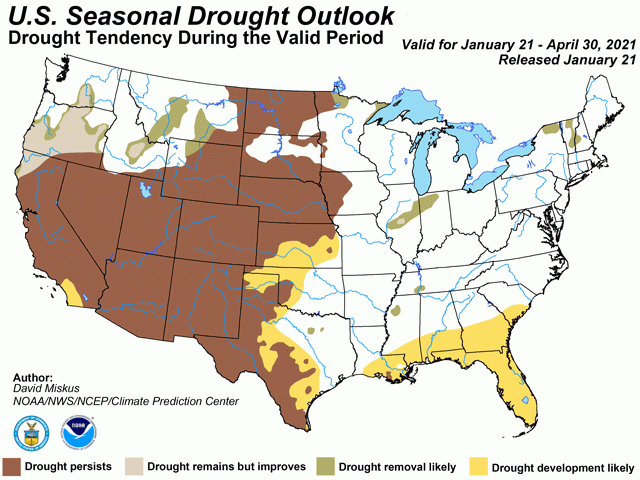Ag Weather Forum
Wide Variability in Spring Forecast
OMAHA (DTN) -- The mid-January NOAA Climate Prediction Center forecasts have a variable prospect for spring (March-to-May) precipitation across the central United States. In the eastern Midwest, precipitation has a strong suggestion of amounts totaling above normal for the season. That's promising, especially in Illinois and Indiana, where moderate to severe drought has been in effect for several months.
In fact, almost the entire northcentral U.S. has been running dry since the end of last year. "Most of the region has had less than 10% of normal precipitation in the past 60 days," said Illinois state climatologist Trent Ford in a NOAA regional forecast conference call. Ford also noted that most of the northcentral region has been dry during the past 90 days. In January 2021, soil moisture profiles in Illinois, Indiana, North Dakota, Nebraska and Kansas are all at less than the 5th percentile -- the lowest 5% of historical ranking. That's dry ground.
"We have had a large decrease in the Midwest with soil moisture at 5 to 10 inches less than a year ago," Ford said. "A lot of the cushion we had (surplus moisture in 2020) is not there now because the soil moisture is depleted."
But while the eastern Midwest has an indication of improved soil moisture conditions, the western Midwest and Plains forecast has a different -- and drier -- story. Near- to below-normal amounts of moisture are forecast for the western Midwest during March to May, with the Plains mainly below normal in the precipitation outlook.
P[L1] D[0x0] M[300x250] OOP[F] ADUNIT[] T[]
The updated seasonal drought outlook from the Climate Prediction Center (CPC) calls for either continued or enhanced drought through the spring west of the Mississippi River.
DTN seasonal forecast maps indicate similar conditions in the outlook.
Spring soil moisture -- or the lack of it -- is high on the list of concerns for Dennis Todey, director of the USDA Midwest Climate Hub in Ames, Iowa.
"If you're in a very dry soil area right now, I would be in some level of increased concern," Todey said. "If your soils are in pretty good shape, I wouldn't sweat things too much at this point." Todey also differentiated between irrigated and non-irrigated areas in the drier-outlook states. "One thing is you have to consider where you are. If you have irrigation, drier conditions in spring are maybe not a big consideration. If you're dryland (non-irrigated), it's more of a concern," Todey said.
However, the prospect of being forced to irrigate just to maintain soil moisture is not an idea that Nebraska Farmers Union President John Hansen likes to think about. Hansen said in dollars and cents, there's a big difference between using irrigation to augment timely rains compared with irrigating to replace a shortage of rainfall.
"High pumping years are seldom high profit years," Hansen said.
Bryce Anderson can be reached at bryce.anderson@dtn.com
Follow him on Twitter at @BAndersonDTN
(c) Copyright 2021 DTN, LLC. All rights reserved.






Comments
To comment, please Log In or Join our Community .